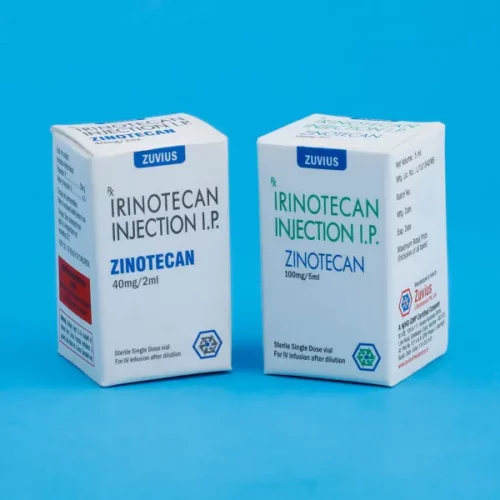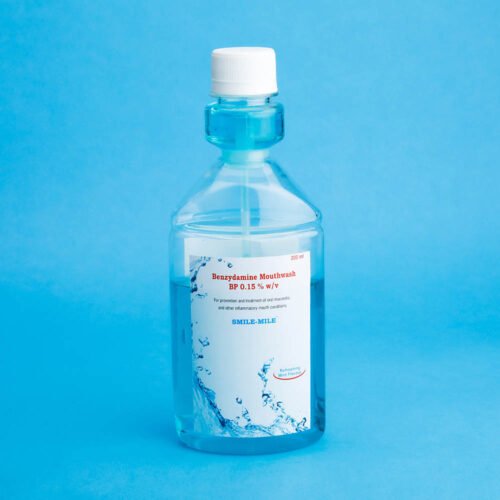Mouth Ease
Lidocain HCl
Strength: 21.30mg
Pack Size: 100 ml
Drug Class: Local anesthetics
Dosage and Administration:
Adults:
The maximum recommended single dose of Lidocaine Hydrochloride Oral Topical Solution, USP (Viscous) 2% for healthy adults should be such that the dose of lidocaine HCI does not exceed 4.5 mg/kg or 2 mg/lb body weight and does not, in any case, exceed a total of 300 mg.
For symptomatic treatment of irritated or inflamed mucous membranes of the mouth and pharynx, the usual adult dose is 15 mL undiluted. For use in the mouth, the solution should be swished around in the mouth and spit out.
This dose should not be administered at intervals of less than three hours, and not more than eight doses should be given in a 24-hour period. The dosage should be adjusted commensurate with the patient’s age, weight, and physical condition.
On the other hand, the Canadian manufacturer advises a lesser number of doses schedule (not more than 6 doses in 24 – hour period). Waiting for at least 3 hours before the next dose is a must.
For use in the treatment of irritated or inflamed mucous membranes of the pharynx, the undiluted solution should be gargled and may be swallowed. However, it must be remembered that this has inherent risks and needs precautionary measures and seeking medical advice at the earliest (See Special Precautions below).
Pediatrics:
Care must be taken to ensure correct dosage in all pediatric patients as there have been cases of overdose due to inappropriate dosing.
It is difficult to recommend a maximum dose of any drug for children since this varies as a function of their age and weight. For children over 3 years of age who have a normal lean body mass and normal body development, the maximum dose is determined by the child’s weight or age. For example: in a child of 5 years weighing 50 lbs., the dose of lidocaine hydrochloride should not exceed 75-100 mg (3.7 to 5 mL of Lidocaine Hydrochloride Oral Topical Solution, USP (Viscous) 2%).
For infants and children under 3 years of age, the solution should be accurately measured and no more than 1.2 mL be applied to the immediate area with a cotton-tipped applicator. Wait at least 3 hours before giving the next dose; a maximum of four doses may be given in a 12-hour period. Lidocaine Hydrochloride Oral Topical Solution, USP (Viscous) 2%) should only be used if the underlying condition requires treatment with a volume of product that is less than or equal to 1.2 ml.
Children should not swallow this medication unless advised by the doctor.
According to US manufacturers, do not give more than 4 doses in a 12-hour period in children. On the other hand, the Canadian manufacturer advises not more than 4 doses in the 24-hour period in children.
Cold Storage: yes
Mouth Ease is Lidocaine hydrochloride USP viscous oral topical solution. Lidocaine, also known as Xylocaine or Lignocaine, is a common and most widely used local anesthetic for pain relief.
Lidocaine hydrochloride, is chemically designated as acetamide, 2-(diethylamino)-N- (2,6 dimethyl phenyl)-, monohydrochloride. The molecular formula of lidocaine is C14H22N2O. The molecular weight is 234.34.

Mouth Ease contains 21.30 mg of Lidocaine hydrochloride per ml, which makes it about 2% w/v formulation, similar to the formulations available internationally.
Lidocaine shows a faster onset of action. It is used topically to relieve itching, burning, and pain from skin inflammation and treatment for mouth ulcers and oral mucositis caused by radiation therapy and chemotherapy. Lidocaine is also useful in pain relief during dental surgeries. Though effective by all routes, the oral route is found to be the most convenient among them. Lidocaine effect is more intense and long-lasting than other local anesthetics such as procaine. It is non-irritating and non-allergic (allergic reactions rare) local anesthetic.
Although many people using this medication do not have serious side effects, lidocaine may cause serious side effects in patients who take it in doses more than indicated, more number of times than prescribed and in more amounts. In addition, some patients are inherently sensitive to its effects. In addition, when used in the treatment of irritated or inflamed pharyngitis, wherein the solution is not only swished in the mouth but maybe swallowed, a host of adverse reactions may occur requiring quick medical attention. Hence sticking to the schedule of taking measured doses at indicated times as advised by the physician and seeking quick medical advice in case of adverse effects is necessary. (See special precautions below).
- For the production of topical anesthesia of irritated or inflamed mucous membranes of the mouth and pharynx.
- It is also useful for reducing gagging during the taking of X-ray pictures and dental impressions.
- Special care needs to be taken when used in the treatment of irritated or inflamed mucous membrane of pharynx. (Refer to Special Precautions).
Usage:
As directed by the physician.
For topical use / surface anesthesia.
Lidocaine stabilizes the neuronal membrane by inhibiting the ionic fluxes required for the initiation and conduction of impulses, thereby effecting local anesthetic action.
- Lidocaine Hydrochloride Oral Topical Solution should be used with extreme caution if the mucosa in the area of application has been traumatized, since under such conditions there is the potential for rapid systemic absorption.
- For patients under 3 years of age, special care must be given to accurately measuring the prescribed dose and not administering the product more often than prescribed.
- The product should only be used for the prescribed indication.
- Patients should be informed that when topical anesthetics are used in the mouth or throat, the production of topical anesthesia may impair swallowing and thus enhance the danger of aspiration. For this reason, food should not be ingested for 60 minutes following use of local anesthetic preparations in the mouth or throat area. This is particularly important in children because of their frequency of eating.
- Numbness of the tongue or buccal mucosa may increase the danger of biting trauma. For this reason, food and/or chewing gum should not be used while the mouth or throat area is anesthetized.
- Patients should be informed that the use of local anesthetics may cause methemoglobinemia, a serious condition that must be treated promptly. Patients or caregiver should be advised to seek immediate medical attention if they or someone in their care experience the following signs or symptoms: pale, gray, or blue-colored skin (cyanosis); headache; rapid heart rate; shortness of breath; light-headedness; or fatigue.
- Lidocaine Hydrochloride should be used with caution in persons with known drug sensitivities. Patients allergic to para-aminobenzoic acid derivatives (procaine, tetracaine, benzocaine, etc.) have not shown cross-sensitivity to lidocaine.
It is usually advised to swish and gargle and spit out the solution. Only in exceptional cases and under medical supervision a patient with irritated or inflamed pharynx may be advised to swallow the well-measured viscous solution, keeping in mind the potential adverse effects and seek medical advice at the earliest occurrence of serious adverse effects like dizziness, drowsiness, slow or shallow breathing, mood changes such as confusion or nervousness, shaking, seizures, vision changes (like double vision or blurred vision), ringing in the ear, fainting, pale/ bluish/gray skin, unusual tiredness, shortness of breath or fast/slow or irregular heartbeats. Though a very serious allergic reaction to this drug is rare, seeking prompt medical attention is indicated in case of rash, itching/swelling (especially of face, tongue, or throat), severe dizziness, or trouble breathing.







